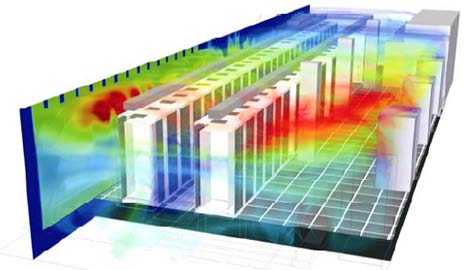
There's a saying in data center circles that "you can't manage what you can't measure." That's why monitoring and analysis are key components of a data center energy efficiency program. There are several approaches to monitoring the data center environment to detect problems and implement improvements.
Wireless monitoring is valuable in data centers because it allows company to retrofit existing data centers to detect "hot spots" where cooling may not be reaching servers. Fine-tuning cooling systems allows data centers to make more efficient use of the energy used by cooling systems, which often consume as much energy as IT equipment. In a wireless monitoring setup, sensors are placed throughout the data center - typically at both the top and bottom of racks - where they record temperature data, which is then transmitted wirelessly to a software management system. The use of wireless sensors avoids the need to run additional cabling in your data center.
How do these systems work? Over the past couple of years, Data Center Knowledge has conducted video interviews with some of the leading providers of data center monitoring technologies, which we'll showcase in this segment of our Data Center Energy Efficiency Guide.
In this video, Jonathan Luce of RF Code demonstrates how his company's RFID tags can gather data on the location and status of equipment, as well as the heat and humidity within the rack. The data can then be remotely displayed and analyzed.
Data center operators use wireless monitoring in a variety of use cases and implementations. In this video, Pete Van Deventer, the president and CEO of SynapSense Corp., discusses some of the evolving trends in data center monitoring.
Some software providers seek to bring together data collected by devices from different vendors throughout the data center. Craig Compiano, CEO of Modius, explains his company's approach to this challenge:
While there are many specialized products for wireless monitoring, some data center providers over the years have adopted a "roll your own" approach to monitoring their facilities:
- Austin colocation provider Core NAP has built a system of low voltage thermal sensors tied together over Cat5 cable, which is summarized at IT Knowledge Exchange: "The monitors report back to a database that can map data center temperatures in real-time. (Core NAP) plans to be able to put multiple monitors in cabinets, under floors, and in the cable runs above of the racks. The sensors from Maxim IC report to USB readers plugged into Linux hosts. The hosts log data to a local web server, and Core NAP plans to combine that info with Visio maps of the data center." Jeremy Porter, the Senior Internet Data Center Architect at Core NAP, says this approach will save money compared to off-the-shelf solutions.
- Fast-growing San Francisco colocation provider United Layer is using forward-looking infrared (FLIR) cameras, as noted by Allen Leinwand recently at GigaOm. An excerpt: "United Layer rents a FLIR camera, the kind typically used to help pilots see at night or in dense fog, to create an infrared thermal image of equipment racks in which inefficient configurations can be easily detected. Once they're found, United Layer works with the customer to redesign their rack layout, improving equipment performance, lifetime and total cost of ownership. Of course, this process also makes it easier to cool the data center, which helps control United Layer's operational costs."
At the other end of the spectrum is data center thermal modeling using Computational Fluid Dynamics (CFD), a tool for analyzing the effectiveness of cooling within the racks and aisles. CFD is used to generate flow simulations with the help of computers, and provides companies with a detailed 3-D analysis of how cold air is moving through a data center, identifying potential hot spots where equipment is receiving too little airflow. Thermal mapping can also find areas in a data center that are receiving more cold air than needed, wasting cooling and energy. CFD is also useful for modeling airflow under a raised floor, which is helpful in designing solutions.
In this video, Applied Math Modeling CEO Paul Bemis demonstrates how to use his company's CoolSim software to create a model of your data center and generate 3-D graphics.
Another leading player in CFD is Future Facilities, which recently updated its 6SigmaDC software to add real-time CFD updates and the ability to share data with popular third-party tools. In this video, Sherman Ikemoto and Tom Wu of Future Facilities provide an overview of the software and demonstrate its capabilities.
The primary drawback of CFD tools is their cost. This week Future Facilities released a new version of its software called 6SigmaRoom Lite with a "less feature-rich and less complex application" in hopes of expanding the pool of potential users.




